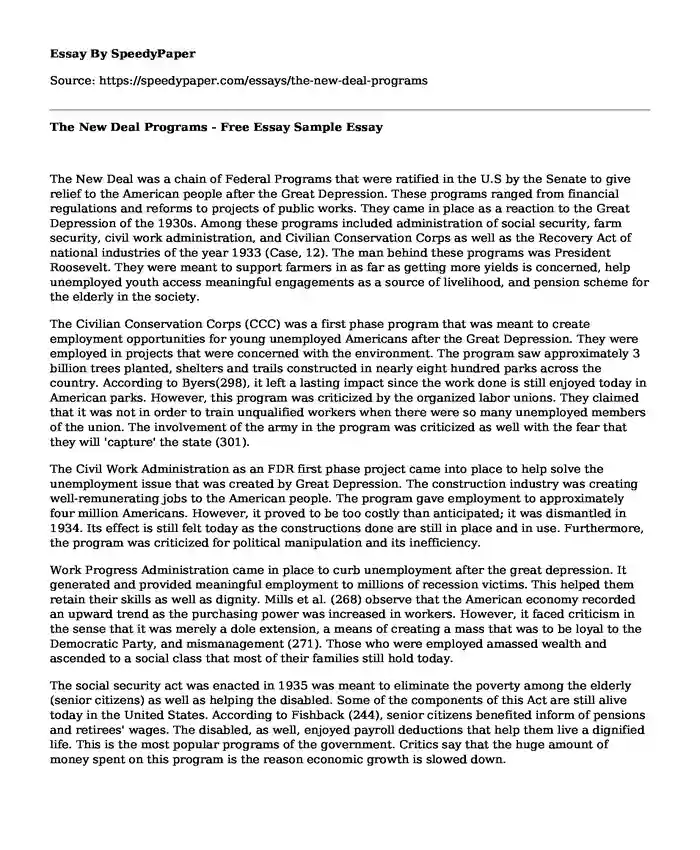
| Type of paper: | Essay |
| Categories: | The Great Depression |
| Pages: | 3 |
| Wordcount: | 736 words |
The New Deal was a chain of Federal Programs that were ratified in the U.S by the Senate to give relief to the American people after the Great Depression. These programs ranged from financial regulations and reforms to projects of public works. They came in place as a reaction to the Great Depression of the 1930s. Among these programs included administration of social security, farm security, civil work administration, and Civilian Conservation Corps as well as the Recovery Act of national industries of the year 1933 (Case, 12). The man behind these programs was President Roosevelt. They were meant to support farmers in as far as getting more yields is concerned, help unemployed youth access meaningful engagements as a source of livelihood, and pension scheme for the elderly in the society.
The Civilian Conservation Corps (CCC) was a first phase program that was meant to create employment opportunities for young unemployed Americans after the Great Depression. They were employed in projects that were concerned with the environment. The program saw approximately 3 billion trees planted, shelters and trails constructed in nearly eight hundred parks across the country. According to Byers(298), it left a lasting impact since the work done is still enjoyed today in American parks. However, this program was criticized by the organized labor unions. They claimed that it was not in order to train unqualified workers when there were so many unemployed members of the union. The involvement of the army in the program was criticized as well with the fear that they will 'capture' the state (301).
The Civil Work Administration as an FDR first phase project came into place to help solve the unemployment issue that was created by Great Depression. The construction industry was creating well-remunerating jobs to the American people. The program gave employment to approximately four million Americans. However, it proved to be too costly than anticipated; it was dismantled in 1934. Its effect is still felt today as the constructions done are still in place and in use. Furthermore, the program was criticized for political manipulation and its inefficiency.
Work Progress Administration came in place to curb unemployment after the great depression. It generated and provided meaningful employment to millions of recession victims. This helped them retain their skills as well as dignity. Mills et al. (268) observe that the American economy recorded an upward trend as the purchasing power was increased in workers. However, it faced criticism in the sense that it was merely a dole extension, a means of creating a mass that was to be loyal to the Democratic Party, and mismanagement (271). Those who were employed amassed wealth and ascended to a social class that most of their families still hold today.
The social security act was enacted in 1935 was meant to eliminate the poverty among the elderly (senior citizens) as well as helping the disabled. Some of the components of this Act are still alive today in the United States. According to Fishback (244), senior citizens benefited inform of pensions and retirees' wages. The disabled, as well, enjoyed payroll deductions that help them live a dignified life. This is the most popular programs of the government. Critics say that the huge amount of money spent on this program is the reason economic growth is slowed down.
Conclusion
Franklin Roosevelt came to power at a time when the country was dealing with the consequences of the Great Depression. His programs were meant to help victims of this period and get the country back on track. However, from the programs like social security act, work progress, and civil work administration, and civilian conservation corps that tremendously improved the lives of the Americans, criticisms remained. For example, critics attacked these programs as political and meant to gain loyalty from masses. They claimed that these programs were expensive for the state. Additionally, they claimed that they were acting as an avenue for people to 'milk' the economy. Most of the contributions generated by these programs are still enjoyed today.
Work Cited
Byers, Philip D. "No Depression in Heaven: The Great Depression, the New Deal, and the Transformation of Religion in the Delta." Christian Scholar's Review 46.3 (2017): 297-301.
Case, Jonathan. The New Deal. Glenat BD, (2018): 12-18
Fishback, Price V. "New Deal." Banking Crises. Palgrave Macmillan, London, 2016. 241-250.
Mills, Albert J., et al. "The new deal, history, and management & organization studies: lessons, insights and reflections." Routledge Companion to Management & Organizational History, Routledge, London (2015): 265-284.
Cite this page
The New Deal Programs - Free Essay Sample. (2022, May 31). Retrieved from https://speedypaper.net/essays/the-new-deal-programs
Request Removal
If you are the original author of this essay and no longer wish to have it published on the SpeedyPaper website, please click below to request its removal:
- Free Essay with the Analysis of the Current Situation with Montreaux Initiative
- The Fisher King - Free Essay on the Hero's Journey
- Artificial Intelligence Research - Free Essay Sample
- 10 Interview Questions - Career Essay Sample
- Essay Example: Policy Making at Local and State Governments
- Essay Sample about Developing a Campaign for School Intimidation
- Big Data in Healthcare - Free Essay Example
Popular categories




